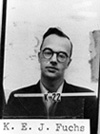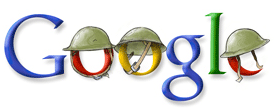"It's yet another in a long series of diversions in an attempt to avoid responsibility." - Chris Knight
Archive for the ‘Geekipedia’ Category
Ike’s Greeting the First Recorded Message From Space
December 19th, 2007 by iDunzo
December 19, 1958: The first radio broadcast from space is transmitted to Earth, with President Eisenhower sending greetings to an international audience.
The technology wasn’t new (a tape recorder was used) but the delivery method was and Ike sounded suitably impressed:
“This is the president of the United States speaking. Through the marvels of scientific advance, my voice is coming to you from a satellite circling in outer space.”
He went on to convey his best wishes, and those of his country, to “all mankind … for peace on earth and good will to men everywhere.”
Eisenhower’s message was prerecorded, then launched into orbit with the U.S. Army’s first Project SCORE experimental satellite.
The primary recorder failed during the satellite’s first orbit but on the second pass the message was successfully transmitted using the backup recorder. Indeed, having a back up plan can be the best life insurance of an important endeavor like this.
Despite the cheery message on board, the satellite’s real purpose was to hang tough with the Russians, who had already put two satellites into orbit — Sputnik 1 and 2 — more than a year earlier.
The satellite, built earlier that year by the Army’s Signal Research and Development Laboratory at Fort Monmouth, New Jersey, was launched aboard an Atlas ICBM provided by the Air Force. It was intended for a low trajectory orbit, meaning a short life.
After 12 days in space the batteries failed and the satellite burned up upon reentering earth’s atmosphere on January 21, 1959.
Source: Space Policy Project
 Posted in Geekipedia + Technology + Trivia |
Posted in Geekipedia + Technology + Trivia |  Comments Off on Ike’s Greeting the First Recorded Message From Space
Comments Off on Ike’s Greeting the First Recorded Message From Space
Laughing Gas Dulls the Pain of a Savage Dentist
December 11th, 2007 by iDunzo
December 11, 1844: Nitrous oxide, also known as laughing gas, is used as a dental anesthetic for the first time.
English chemist Joseph Priestley, discoverer of oxygen, first synthesized nitrous oxide in 1775. Priestley, however, was content with having “discovered an air five or six times as good as common air.”
He did not experiment with inhalation, however, so did nothing toward developing its practical and recreational uses.
Nitrous oxide, along with chloroform and ether, became popular anesthetics. While not sufficiently effective as general anesthetics for the modern operating theater, all were effective enough to become popular in dentistry. Of the three, nitrous oxide is still widely used.
Nitrous oxide is also used as an aerosol-spray propellant, especially in whipped-cream canisters and cooking sprays. Its solubility in fatty compounds allows for up to four times as much whipped cream to be produced as the liquid contained in the can.
Owing to its nontoxicity and relatively easy storage, nitrous oxide is also a popular oxidizer for rocket motors and is used in car racing to boost power.
Outside the commercial world, nitrous oxide is best known for its recreational use as an inhalant for getting high. The resulting euphoria is often accompanied by some pretty loopy behavior, which is where the “laughing gas” moniker comes from.
For every upside there’s a downside, though, and nitrous oxide’s is considerable. It’s a major greenhouse gas and therefore a major contributor to global warming.
 Posted in Geekipedia + Technology + Trivia |
Posted in Geekipedia + Technology + Trivia |  Comments Off on Laughing Gas Dulls the Pain of a Savage Dentist
Comments Off on Laughing Gas Dulls the Pain of a Savage Dentist
Google and I remember Veterans Day 2007
November 11th, 2007 by iDunzo
Here in America it’s Veterans Day, the day we celebrate the tens of millions of people who gave their sweat and blood, and sometimes their lives to serve our country.
I’m a proud U.S. Marines Veteran and did my duty in active duty during Desert Storm in the Persian Gulf. Today means a lot to me, my friends and family.
A little trivia, Desert Shield and Desert Storm Operations were the largest U.S. deployment of naval forces since World War II.
Today Google shows respect with a colorful home page logo:
You can read the complete History of Veterans Day on the U.S. Department of Veterans Affairs site.
On this Veterans Day 2007, we come together as a Nation to thank our veterans (the Army, Navy, Air Force, Marines and Coast Guard) for their service and to let them know that their service and sacrifices will never be taken for granted.
 Posted in Geekipedia + Google + Memories + Technology |
Posted in Geekipedia + Google + Memories + Technology |  1 Comment »
1 Comment »
Google Celebrates Halloween 2007
October 31st, 2007 by iDunzo
Halloween, or Hallowe’en, is a holiday celebrated on the night of October 31 and today Google gives us a spooktacular logo:

Traditional activities include trick-or-treating, Halloween festivals, bonfires, costume parties, visiting “haunted houses”, carving jack-o-lanterns, and viewing horror films.
Halloween originated from the Pagan festival Samhain, celebrated among the Celts of Ireland and Great Britain.
Irish and Scottish immigrants carried versions of the tradition to North America in the nineteenth century.
Other western countries embraced the holiday in the late twentieth century.
Source: Wikipedia
 Posted in Geekipedia + Google + Search + Technology |
Posted in Geekipedia + Google + Search + Technology |  Comments Off on Google Celebrates Halloween 2007
Comments Off on Google Celebrates Halloween 2007
Alaska Highway Opens as a Hedge Against Invasion
October 29th, 2007 by iDunzo
October 29, 1942: The Alaska Highway officially opens to military traffic.
Until the early 1940s, Alaska was a neglected U.S. territory. The Klondike gold rush of the 1880s and ’90s was a distant memory, and oil had not yet been discovered.
There were a bunch of trees and rivers and snow, but nothing really worth exploiting, so the vast wilderness was pretty much left to the bears and the hardy few who lived on the frontier.
Although proposals had existed since the 1920s for building a highway through western Canada into Alaska, the Canadian government wasn’t very keen, and the plans were shelved.
The Japanese attack on Pearl Harbor on Dec. 7, 1941, coupled with their military incursions into the Aleutian Islands, changed things in an instant.
Suddenly, Alaska became a potential Japanese invasion route to Canada and the Lower 48, so both governments agreed that the road would now be built.
Military necessity dictated the route. It was a far cry from the original highway-commission blueprints and their more topographically friendly, meandering roadways.
The Alaska Highway — like the Burma Road for moving Allied supplies from northern Burma to China — would take little account of mountains, wilderness, water or elevation.
The U.S. Army assumed control of the project, and the Corps of Engineers — augmented by thousands of civilian contractors — began construction through the northern wilderness. By any measuring stick, it was grueling, backbreaking work.
A Canadian army observer remembers:
Those U.S. troops — I felt sorry for them to begin with — then was amazed at what they did. If you weren’t there, you just couldn’t understand it. I saw fellows so tired, they were ready to drop in their tracks. It was rush-rush-rush. Fellows were doing 18 to 20 hours a day on bulldozers. One was up to his neck in ice water repairing timbers in subzero weather. God, I admired them. Most were southerners — they’d never experienced cold like that. And in the summer, it was mosquitoes — like they’d eat you right there, or pack you away to eat at home.
In the end, the 1,500-mile highway, stretching from Dawson Creek in British Columbia to Fairbanks, Alaska, was completed in an astounding eight months.
In many places, it was a “highway” in name only, instead resembling a glorified footpath with stretches of unpaved road, murderous switchbacks and no guard rails or shoulders.
Apparently vehicles had a tough time negotiating the road, and traffic didn’t really pick up until 1943.
After the war, major improvements were made to the highway, and it opened to general traffic in 1947 after wartime travel restrictions were lifted.
 Posted in Geekipedia + Technology + Trivia |
Posted in Geekipedia + Technology + Trivia |  Comments Off on Alaska Highway Opens as a Hedge Against Invasion
Comments Off on Alaska Highway Opens as a Hedge Against Invasion
Red Spy Steals U.S. Atom Bomb Secrets
October 18th, 2007 by iDunzo
 October 18, 1945: Klaus Fuchs passes U.S. atomic bomb secrets to the Soviet Union for the first time.
October 18, 1945: Klaus Fuchs passes U.S. atomic bomb secrets to the Soviet Union for the first time.
Between 1945 and 1947, working with a courier known only as Raymond, Fuchs delivered high-level information on the atomic bomb, then later the hydrogen bomb, to Moscow.
Fuchs was a refugee from Hitler’s Germany, fleeing to England in 1933, where he completed his doctorate in physics.
At the outbreak of World War II, Fuchs, still a German citizen, was interned as an enemy alien but soon released through the intervention of Max Born, a professor at Edinburgh University and another German refugee.
Fuchs was recruited as a theoretical physicist for the British atomic bomb project, and became a British subject in 1942.
The following year, he was among several British scientists sent to the United States to collaborate on the Manhattan Project.
After being sent to the weapons laboratory in Los Alamos, New Mexico, Fuchs spent his time devising a method of imploding the fissionable core of the plutonium bomb.
He was present at the Trinity test in July 1945, where an atomic bomb was successfully detonated for the first time.
Through it all, however, Fuchs remained a committed communist. He had joined the party while still living in Germany and fled the country for his political beliefs, not his religion. He was a Lutheran.
Consequently, he had tremendous sympathy for the Soviet Union and its life-and-death struggle with Nazism.
He also had grave misgivings about the United States being the only power on earth to possess the bomb.
By 1948, the Americans were aware that the Russians had people inside their nuclear program but Fuchs eluded suspicion until the following year, by which time he had returned to England.
Confronted by British intelligence, which identified him after cracking a Russian code, he eventually confessed and was sentenced to 14 years in prison.
Following his release in 1959, Fuchs went to East Germany and lived there until his death in 1988.
Historians on both sides of the Cold War have long debated the actual value to the Russians of Fuchs’ information.
Asked after Fuchs’ death about the importance of what he had given the USSR, Edward Teller said:
“Oh, not very important. I’m sure the Russians knew how to build a bomb without Fuchs’ stuff.”
Sources: Atomicarchive.com and Crimelibrary.com
 Posted in Geekipedia + Technology + Trivia |
Posted in Geekipedia + Technology + Trivia |  Comments Off on Red Spy Steals U.S. Atom Bomb Secrets
Comments Off on Red Spy Steals U.S. Atom Bomb Secrets

